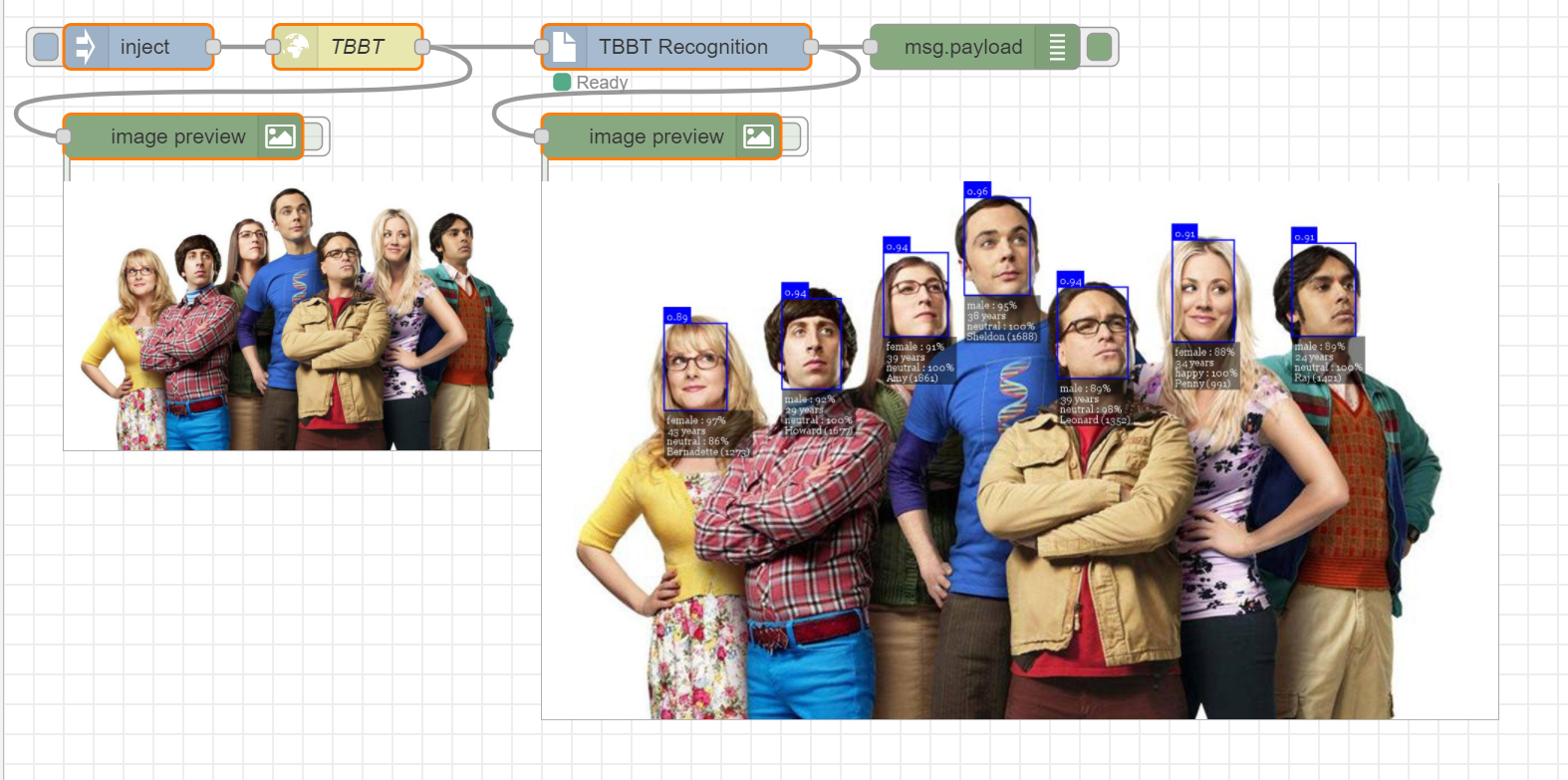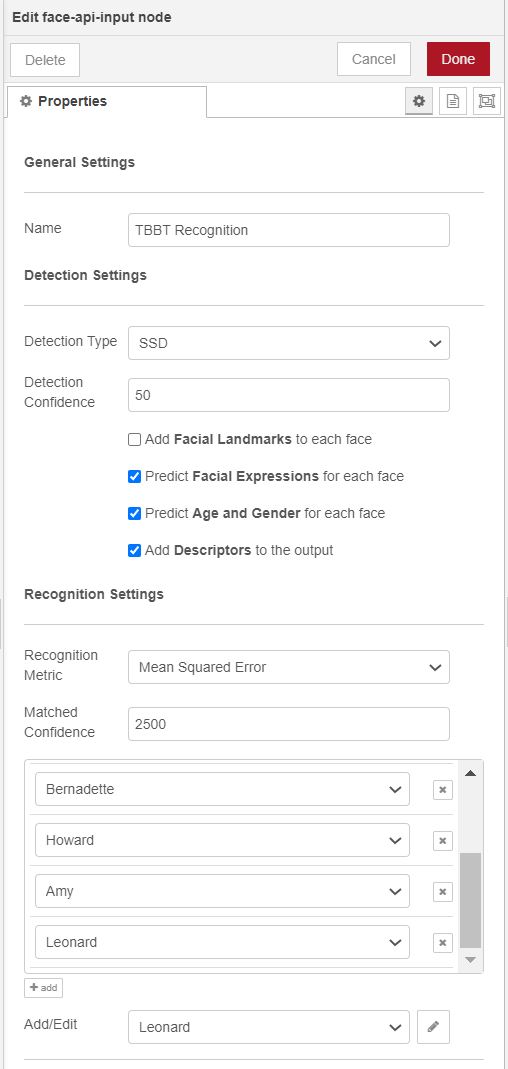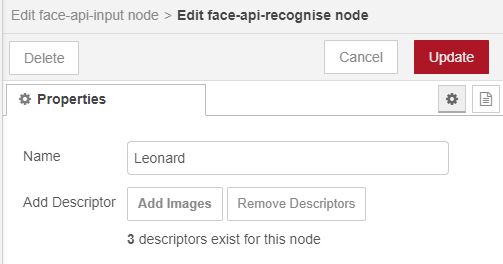node-red-contrib-face-recognition 2.0.4
A wrapper node for the epic face-api.js library
node-red-contrib-face-recognition
Version 2 Out Now!
Version 2.0.0 is now officially released brining performance increases, better useability, and more support across systems. Testing is still ongoing, so if you come across any bugs please open an issue or a discussion here.
Overview
This node aims to wrap the epic Face-API.js library from justadudewhohacks into a simple to import and use node in Node-Red. If you like anything in this repo be sure to also check out the original.

Usage of this node is designed to be very easy while allowing the user to choose any number of options exposed by the original face-api.js module. These are currently;
- Face detection
- Facial Landmarks
- Facial Expressions
- Age and Gender Predictions
- Facial Recognition
This module also utilizes the child_process module of Node.js to offload the complex calculations required to a separate thread. In turn, the offloaded task will not block the main event loop and allow Node-Red to continue other tasks. Each input node spawns a new fork, which will consume memory, so this may want to be limited on resource restricted environments.
Installation
From your .node-red directory, you can run;
npm install node-red-contrib-face-recognition
or you can go to the pallette manager in Node-Red and find node-red-contrib-face-recognition in the install tab.
Canvas
Canvas will be installed correctly providing when using either installation method, however the required packages need to be installed on the system. These are as follows for several common OS's;
Windows
No requirements
Mac
¯\_(ツ)_/¯
Linux (Debian Based)
apt-get install -y python \
g++ \
build-essential \
libcairo2-dev \
libjpeg-dev
Official Docker Image
apk add python \
g++ \
build-base \
cairo-dev \
jpeg-dev \
pango-dev \
musl-dev \
giflib-dev \
pixman-dev \
pangomm-dev \
libjpeg-turbo-dev \
freetype-dev
TensorFlow for Node.js (Optional)
You can also optionally install TensorFlow for Node.js to make this package run faster. If you do not, the node will still run albeit much slower. To install TensorFlow navigate to your .node-red folder and run the following command. This will install TensorFlow in your Node-Red directory for use by the node.
npm install @tensorflow/tfjs-node
There are known issues with the working combinations version of Node.js, @tensorflow/tfjs-node and face-api.js. At the time of writing this, these were found to be;
- Node.js: 10.16.3
- @tensorflow/tfjs-node: 1.2.11
- face-api.js: 0.21.0
Please install these to gain the speed of the tf c++ backend and keep up to date on the face-api.js GitHib page for any errors relating to this.
tfjs-node is unfortunatley not supported on all OS's and all architectures. Below is a table of where they are supported;
| OS | x86 | armv7 | arm64v8 |
|---|---|---|---|
| Windows | yes | - | - |
| Mac | ? | - | ? |
| Linux (Debian based) | yes | no | yes |
| Official Docker Image | no | no | no |
| Unofficial Docker Image | yes! | soon | yes! |
Example Flow
As an example on how to use the node, below is a flow that grabs an image from the internet and runs inference over it. Copy and paste it into Node-Red to use, but make sure to install the following nodes from the pallet manager;
- node-red-contrib-image-output
Note: In order to recognise faces you will need to add the recognise config nodes yourself as these cannot be exported across instances.
[{"id":"c08c9d7b.c2377","type":"image","z":"4eb4b426.c9cfcc","name":"","width":"320","data":"payload","dataType":"msg","thumbnail":false,"pass":false,"outputs":0,"x":120,"y":100,"wires":[]},{"id":"461f82e0.80fc8c","type":"image","z":"4eb4b426.c9cfcc","name":"","width":"640","data":"payload.labelled_img","dataType":"msg","thumbnail":false,"pass":false,"outputs":0,"x":440,"y":100,"wires":[]},{"id":"453418e3.520f28","type":"face-api-input","z":"4eb4b426.c9cfcc","name":"TBBT Recognition","model":"SSD","confidence":50,"input_size":"128","landmarks":false,"expressions":true,"age_gender":true,"descriptors":true,"match_metric":"Mean Squared Error","match_confidence":"2500","recognise_nodes":["a88d60e.9ca13a","5d6c06f7.11d2c8","71bfb897.3b8ef8","e09c0d5.ca5acf","dc3c3afc.04e708","eb7ecb3c.a1cbb8","b4b62a6d.fc5c18"],"recognise_node_editor":"b4b62a6d.fc5c18","x":450,"y":40,"wires":[["461f82e0.80fc8c","4d4a98a1.c04008"]]},{"id":"d7b82011.6cfd1","type":"http request","z":"4eb4b426.c9cfcc","name":"TBBT","method":"GET","ret":"bin","paytoqs":"ignore","url":"https://www.etonline.com/sites/default/files/images/2019-05/bigbangtheory.jpg","tls":"","persist":false,"proxy":"","authType":"","x":230,"y":40,"wires":[["453418e3.520f28","c08c9d7b.c2377"]]},{"id":"492a9534.4d694c","type":"inject","z":"4eb4b426.c9cfcc","name":"","props":[{"p":"payload","v":"","vt":"str"},{"p":"topic","v":"","vt":"string"}],"repeat":"","crontab":"","once":false,"onceDelay":0.1,"topic":"","payload":"","payloadType":"str","x":90,"y":40,"wires":[["d7b82011.6cfd1"]]},{"id":"4d4a98a1.c04008","type":"debug","z":"4eb4b426.c9cfcc","name":"","active":true,"tosidebar":true,"console":false,"tostatus":false,"complete":"false","statusVal":"","statusType":"auto","x":650,"y":40,"wires":[]},{"id":"b4b62a6d.fc5c18","type":"face-api-recognise","name":"Leonard"}]
Included Nodes
This module comes with two nodes; the face-api-input node and face-api-recognise node.
Input node
Description
The face-api-input node is the main node that runs inference over an input image and optionally utilised recognition nodes to recognise faces. Each input node spawns a fork which is a seperate nodejs instance to run the recognition on to avoid blocking the main node-red event loop. This takes resources, be be conservative on resource constrained environments.
General Settings
- Name: The name of this specific node. Useful to change when you have multiple config nodes and need to know the difference between them. (defaults to "face-api-input")
Detection Settings
Detection Type: The detection type to use. This is either
SSDorYolo, asMTCNNis not currently supported. (Defaults to SSD)Input Size: The input size of the Yolo algorithm. This option is only available when using Yolo as the type. (Defaults to 416)
Detection Confidence: The minimum confidence score that each detected face much be above to be counted as a face. This option is available for both SSD and Yolo. (Defaults to 50%, Limited between 0 and 100)
Facial Landmarks: Select this if you would like to add facial landmarks of each face to the output. (Defaults to false)
Facial Expressions: Select this if you would like to add a prediction of facial expressions of each face to the output. (Defaults to false)
Age and Gender: Select this if you would like to add a prediction of the age and gender of each face to the output. (Defaults to false)
Descriptors: Select this if you would like to output the computed descriptors for each found face. (Defaults to false)
Recognition Settings
Recognition Metric: Select the type of recognition metric to use when comparing faces with the recognition option. This is option is only shown when the recognise option is selected. (Defaults to Mean Squared Error)
Matched Confidence: This is the minimum cutoff value for recognition for each of the metrics. Keep in mind that the different metrics will produce different ranges of values for recognition. This is option is only shown when the recognise option is selected. (Typical cutoffs are around 2000)
Recognise Nodes List: A list of recognition nodes to run recognition against for each face found in an input image. Simply add and remove as many as required, there are no limits
Add/Edit Recognise Nodes: Use this dropdown menu to add and edit new recognise nodes which you can then add to the input node list. Keep in mimd you will have to deploy the node before being able to find it in the list.
Compute Node
Name: The name of this specific face to recognise. (defaults to "Unknown")
Add Images: Use this button to add images to create a descriptors from. These descriptors will then be used in the input node to predict against an image. When adding images, the descriptors will take a while to compute.
Remove Descriptors: Use this button to remove the currently stored descriptors. This is irreversible.
Adding a face descriptor
In order to use the facial recognition, facial descriptors must be calculated first to allow a comparison between them and any input image. To do this, create a recognition node through the input node menu, then click Add Images. Once selected all images will be computed immediately in the background.
These descriptors are then saved to disk allowing it to survive restarts of Node-Red. The saved file will then be loaded on startup of Node-Red. Saving the descriptor is also safer than saving an image if your Node-Red instance is online as no data about the original image is stored.
The Recognition Metric
The original Face-api.js library only supports the Euclidean distance method of comparison between descriptors when matching faces. To extend this, this node also supports 3 more type of metrics. These are; Manhattan, Chebyshev, and Mean Squared Error.
The outputs of these metrics from the node are all mapped roughly to the same output values of around 0 to 10000. This was to make it easier to compare the usefulness of each and allow the user to set a cutoff value within a similar range for each metric.
From testing, Mean Squared Error gives the highest contrasting results from known to unknown faces. If you have another metric you feel may be useful, feel free to submit a pull request or create a discussion as I can now implement it along with the others.
Contributing
If you like this node and want to contribute feel free to fork this repo and make a pull request. New features and suggestions are welcome, and there are several features I would like to implement, but lack the Javascript knowledge in Node.js. These are;
- Help on implementing tfjs-node on all platforms.
- General code improvements and clean ups






